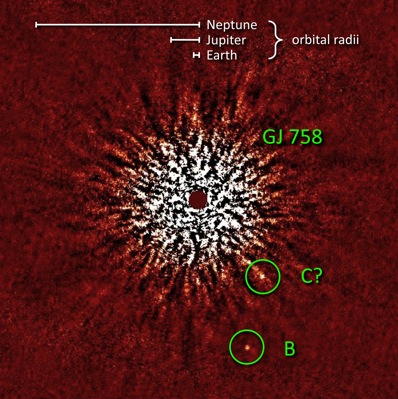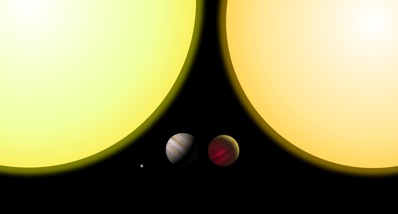
Subaru spots companion to Sun-like star
DR EMILY BALDWIN
ASTRONOMY NOW
Posted: December 4, 2009


The first direct observation of a planet-like object orbiting a star similar to our Sun has been made with a new generation instrument on the Subaru Telescope.
The object, known as GJ 758 B, is between 10 and 40 times the mass of Jupiter and could either be a large planet or a brown dwarf. Brown dwarfs are not massive enough to sustain nuclear fusion in their cores and so are often referred to as failed stars. At around 315 degrees Celsius, the object is relatively cold for a body of its size – in fact it is the coldest companion to a Sun-like star ever recorded in an image.
 The Subaru Telescope's HiCIAO instrument measures differences in heat. Two candidate planets are identified in the GJ 758 system, which resides just 300 trillion miles from Earth. Image: Max Planck Institute for Astronomy/National Astronomical Observatory of Japan. The Subaru Telescope's HiCIAO instrument measures differences in heat. Two candidate planets are identified in the GJ 758 system, which resides just 300 trillion miles from Earth. Image: Max Planck Institute for Astronomy/National Astronomical Observatory of Japan.
“It’s a groundbreaking find because one of the current goals of astronomy is to directly detect planet-like objects around stars like our Sun,” says Princeton University's Michael McElwain. “It is also an important verification that the system – the telescope and its instruments – is working well.”
The detection was enabled by using the High Contrast Coronagraphic Imager with Adaptive Optics (HiCIAO) instrument to block out the blinding glare of the sun, revealing the fainter object. While other planet-like objects have already been observed directly, most have been on larger orbits than the distance between GJ 758 B and its star, or around stars with temperatures far above the average temperature of GJ 758 or our Sun.
“This challenging but beautiful detection of a very low mass companion to a Sun-like star reminds us again how little we truly know about the census of gas giant planets and brown dwarfs around nearby stars,” says Alan Boss, an astronomer at the Carnegie Institution for Science, who was not involved in the research. “Observations like this will enable theorists to begin to make sense of how this hitherto unseen population of bodies was able to form and evolve.”
 Size comparison (from left) between the Sun, the Earth, Jupiter, GJ 758 B and GJ 758. Image: Max Planck Institute for Astronomy/National Astronomical Observatory of Japan. Size comparison (from left) between the Sun, the Earth, Jupiter, GJ 758 B and GJ 758. Image: Max Planck Institute for Astronomy/National Astronomical Observatory of Japan.
GJ 758 B currently resides at the equivalent distance from its host as Neptune is from the Sun, but further observations will be required to determine the size and shape of its orbit. A curiosity of the observation is that a large planet like this is expected to form much closer or much further away from their host star, but not in the location where GJ 758 is now.
Telescope images also revealed a second companion to the star, GJ 758 C. More observations, however, are needed to confirm whether it is nearby or just looks that way. “It looks very promising,” says Christian Thalmann, one of the team’s lead scientists. If it is a second companion then the duo are much more likely to be young planets rather than old brown dwarfs, since two brown dwarfs in such proximity would not remain stable for such a long period of time.
|



